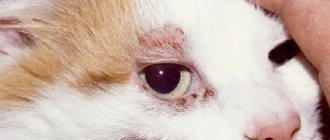Many cat owners do not know whether a person can become infected with ear mites from their pet. Ignorance in this matter sometimes leads to absurd actions when animals are isolated from all family members in a separate room, and sometimes even thrown out onto the street.
In fact, ear mites in cats are not contagious to humans. In addition, the owner himself can be a source of infection for his pet if he brings the pathogen into the house on clothes or shoes.
Ear mites: what is it, where does it come from and why is it dangerous?
Ear mites are small parasites - Otodectes cynotis, localized in the external auditory canal of the animal and feeding on particles of the epidermis, blood and lymph. Their body is colored light yellow, has an elongated oval shape and does not exceed 0.6 mm in length. The vital activity of the parasite leads to injury to the sensitive surface of the inner part of the ear and contributes to the development of otodectosis, or ear scabies - a serious invasive pathology, accompanied in most cases by a bacterial infection. Severe advanced forms of otodectosis can lead to the death of the animal.
This is what an ear mite looks like under a microscope
Both dogs and cats can become infected with ear mites, but otodectosis is more common in representatives of the cat family. Ear mites are usually not dangerous to humans. People can carry the parasite and infect their pet.
How does infection occur?
There are several options for where ear mites come from. Animals that regularly walk outside suffer the most from parasite attacks. Not only ticks, but also other dangerous parasites lie in wait for them in the grass or garbage, in basements and attics. A healthy pet can become infected after contact with a sick animal, through care items - a comb, a carrier, etc. Owners are surprised when a tick appears on a pet that does not go outside. In this case, the culprit of the infection is the person himself - the parasite can be brought into the room on shoes, clothes, or hands. Often ticks are carried by flies or fleas.
Otodectosis is characterized by seasonality. In most cases, infection occurs during warm weather, which is favorable for the parasite. Outside the animal's body, Otodectes cynotis can exist for up to two months. If during this time the parasite does not find a host, it will die. Ear scabies most often affects pets under one year of age. Adults become infected from sick animals or when their immunity is weakened.
Why are ear mites dangerous?
Ear mites themselves are not dangerous and require simple therapy. But if left untreated, the disease can lead to serious consequences:
- intensive scratching will cause damage to blood vessels, which will lead to the formation of a hematoma;
- the skin of the inner surface of the ear will swell and become inflamed, and the pet will develop otitis media;
- the animal will gradually lose hearing;
- possible damage to the eardrum will cause inflammation of the middle and inner parts of the ear, which will ultimately lead to inflammation of the meninges and death of the animal.
On the left is the initial stage of ear mite infection, on the right is a very advanced case
Causative agent of ear scabies
The causative agent of otodectosis (Otodectes cynotis) in cats is a microscopic mite, the length of which does not exceed 0.3-0.7 mm. The oval grayish-brown body of the parasite is equipped with four pairs of limbs with suckers. The last pair of legs is greatly shortened, so it is barely noticeable under a microscope. On the front of the body there is a horseshoe-shaped proboscis.
Ear mites feed on cells of the exfoliated epithelium of the ear canal and tissue fluid that appears on the surface of the skin. At the same time, the waste products of parasites irritate the surface epithelium of the external auditory canal and provoke intensive production of sulfur.
The accumulation of sulfur, blood, secretions and excrement of mites in the first stages of the disease forms brown dried crusts. With the further development of otodectosis, these secretions accumulate in the form of a tar-like mass with an unpleasant odor.
Symptoms of infection
The symptoms that you need to pay attention to first in order to promptly detect otodectosis in a cat or kitten include:
- the appearance of redness and peeling of the inner surface of the ear;
- restless behavior of the animal - due to annoying itching, the cat shakes its head and constantly scratches its ears;
- release of fluid - exudate;
- the appearance of bald patches and areas with glued hairs in the lower part of the ear;
- the formation of dark brown scabs;
- unpleasant odor due to accumulations of pus;
- crooked head - in complicated forms of infection, the animal tilts its head towards the affected ear.
The owner should keep in mind that the consequences of a seemingly harmless pathology in the absence of therapy can be disastrous.
general information
In cats, both ears are usually infected, because... The animal itself transfers the parasite when washing from the diseased ear to the healthy one. Symptoms of infection soon appear and the pet experiences discomfort.
First sign
Once in the ear, the parasite eats away the skin and mucous tissue.
The cat suffers from severe itching, scratches continuously, and shakes its head.
How to spot a tick
It is difficult to see a tick with the naked eye, but you can identify it by its characteristic signs: brown discharge with an unpleasant odor accumulates in the cat’s ear canals. These are waste products of microscopic pests.
At the veterinary clinic, ear exudate is analyzed under a microscope. Using optics it is easy to detect parasitic arthropods.
What do parasites eat?
Pests feed on skin, blood, lymph, and ear secretions (wax). By burrowing under the skin, the parasites actively multiply and gnaw their passages right in it.
Numerous lesions in which waste products of mites accumulate, become inflamed, irritate the nerve endings, and cause itching.
Discomfort
The animal experiences itching and unpleasant sensations when mites penetrate the layers of the skin, gnawing and injuring them. Painful sensations develop later when otitis media develops.
Consequences of improper treatment
If the animal is treated at home using traditional methods or the situation is completely abandoned, the inflammation will penetrate into the middle ear and otitis media will develop. The disease will become chronic and the cat may lose hearing.
Is the animal contagious?
Cat ticks are not transmitted to humans. The parasite is not dangerous for either adults or children. These pests, like fleas, do not parasitize the human body, but can cause allergic reactions.
The owner of a sick pet is a carrier of otodectosis and is contagious to other animals.
The disease is transmitted from an infected individual to dogs, rabbits, and guinea pigs. Kittens most often suffer from this infection.
Where do ticks come from?
The parasite is not always transmitted from a sick individual to a healthy one; it can be brought into the house on the shoes of the owner.
If stray cats live on the landing of an apartment building, the infection will easily penetrate the apartment and the pet will suffer. Fleas, lice eaters and flies are also carriers of the infection.
Diagnostics
If you suspect an ear mite infestation, you should immediately contact a specialist. Only he will prescribe the optimal treatment option. Before visiting the veterinarian, the owner can verify for himself whether the animal has a parasite. For this you need a cotton swab and dark material. The stick should be used to clean out as much of the mass present in the pet’s ear as possible. Then it should be tapped over a dark surface in order to shake off the parasite. Having directed a bright light at the material and armed with a magnifying glass, you should observe the extracted secretions for some time. If after about a couple of minutes moving, small yellowish dots become noticeable, it means that your pet is developing otodectosis.
Prevention
As a preventive measure, do not forget about the hygiene of your cat and regularly inspect and clean the ears using specialized hygienic drops "Bars" and do not forget about the quarterly treatment of the animal against fleas and ticks with drugs: Frontline, Advantix, etc.
In addition, do not neglect regular cleaning using insecticidal agents of all areas where the animal is. Keep the bedding and all cat care items clean, and make it a rule to never use other people's items.
Treatment of ear mites in cats
Today, veterinary pharmacies sell many drugs to rid animals of ear mites. They are available in the form of ointments, drops, and aerosols. Despite the wide range, you should carefully select drugs for therapy because some do not help at all, others give only a temporary effect, and there are others that cause unwanted reactions and even complicate the course of the disease.
Drugs for the treatment of otodectosis must be selected taking into account the age of the animal and its condition - pregnancy, the presence of another disease. It is also important to follow the instructions exactly - the drugs are not harmless and, if used incorrectly and in excess of the dose, can harm the animal, especially if it is a kitten.
The procedures for the treatment of uncomplicated pathology are quite simple - the owner, using medications recommended by the veterinarian, can carry them out independently. In advanced forms of the disease, antibiotics and Otodectin injections may be needed.
To rid an animal of ear scabies, you will need drops or ointment directly to treat the pathology, preparations for cleansing the auricle and an insecticidal agent for application to the withers.
Drugs for the treatment of otodectosis should be purchased exclusively in special pharmacies. You should not take risks and buy medicines on the market.
The following remedies have proven themselves to be effective in the treatment of ear scabies:
- Otoferonol Gold. It has a complex effect - not only gets rid of infection, heals wounds, relieves inflammation, but also has an acaricidal effect - that is, it destroys ticks. The drug is not used for pets who are not yet two months old, and it is also contraindicated for females bearing cubs. The course of therapy is a double application with an interval of 7 days. Dose for cats: 3-4 drops in each ear canal.
- Amitrazine. Drops relieve inflammation, eliminate itching and have an acaricidal effect. The dosage should be calculated based on the recommendations specified in the instructions. Typically, for adult cats, a drop of 0.5 ml in each ear is sufficient. The procedure is carried out once a day, every three days. Usually it is enough to carry out 4-5 treatments. The drug is contraindicated in pregnant females.
- Decta. The drug contains an antibiotic. The product eliminates discomfort and destroys the causative agent of the disease. The animal is instilled with 3-5 drops in each ear. Treatment is carried out at intervals of 5 days. The drug is not used for the treatment of pregnant cats and kittens up to one month old.
- Aversectin ointment. The drug is used 2 to 4 times at weekly intervals. The product is contraindicated for cats bearing offspring and kittens under 2 months.
- Amidel-gel. Anesthetizes and destroys parasites. Treatment is carried out 2 to 5 times with an interval of 7 days. The product should not be used to treat kittens less than two months old and pregnant females.
For preliminary cleansing of the auricle, the budget product Bars or regular vegetable oil is suitable. To treat the withers, it is more convenient to use a spray - Cyodrin, Dermatosol, Frontline or any other that gets rid of skin parasites.
Rules for treating animals against parasites
Before using a medicinal drug to get rid of otodectosis, the auricle is cleaned with a special product or oil. Cleaning must be carried out even if the instructions for the medicinal product say that you can do without it. Cleansing will help the healing drops penetrate deep into the ear canal for a more effective effect. Use the cleaning product according to the instructions. When treating with vegetable oil, you should drip it into each ear, in the amount of 5 drops, and massage, blot the remainder with a cotton pad.
Do not clean the animal's ears with cotton swabs - this can promote deeper penetration of the infection and also cause injury.
After cleansing, you should drop the drug for the treatment of ear scabies into each ear of your pet, following the dosage recommendations specified in the instructions. Then you need to massage the base of the ear so that the product penetrates into hard-to-reach places. Next, you should hold your pet's head so that he does not shake out the medicine. The final stage of treatment is to wipe the inner surface of the ear and the area around it with a disc soaked in the same preparation.
To treat ear scabies in pregnant cats and kittens, special products should be used. Cleaning with sunflower oil, rubbing with hydrogen peroxide and instilling camphor oil in an amount of 2-3 drops can be one of the completely safe methods of treating otodectosis in kittens and pregnant animals.
During therapy, ear mites may move to the pet's body. In this case, you should treat the animal with an antiparasitic spray or apply special drops to the withers. After such treatment, you need to ensure that the cat or kitten does not lick itself for some time. The spray can also be applied to places where the animal usually rests.
To alleviate the animal's condition between treatments, Otonazole can be used. The drug has an anti-inflammatory, antimicrobial effect, and relieves annoying itching.
To speed up the healing process, you should take care of your pet’s immunity. His diet should be balanced, rich in useful elements and vitamins. A course of injections of immunomodulatory drugs, such as Gamavit or Tentravit, will also be useful.
Special drops should be used to clean the cat's ear.
Diagnosis and treatment
If your cat shows signs of otodectosis, you should show him to a veterinarian. He will take a scraping, establish the correct diagnosis and prescribe treatment.
Usually, treating otodectosis is not difficult - it will involve procedures for cleansing the ear and instilling special drops. Antihistamines and special ointments will help relieve irritation and redness from scratching.
If, in addition to the tick itself, there is fungal or bacterial infection, then additional antibacterial and antifungal drugs will be prescribed.
Folk remedies for ear mites
Folk remedies are recommended to be used only at the initial stage of infection, for prevention or as an auxiliary method of treatment. To cleanse the inner surface of the ear from crusts and scabs, you can use regular sunflower oil, as well as camphor or vaseline oil. For processing you will need cotton pads. Excess oil should be blotted off.
For disinfection purposes, you can use a 3% hydrogen peroxide solution. A cotton pad should only be slightly moistened with the product and gently wipe the infected area with it. In this case, you need to make sure that the peroxide does not flow deep into it.
A strong infusion of green tea is suitable as an antiseptic - a dessert spoon in half a glass of boiling water. Wipe the ears with a warm solution using a cotton pad.
Garlic is an excellent antiseptic, but it cannot be used in its pure form to treat your pet’s ears - it can provoke even greater irritation of the problem area. In the complex treatment of otodectosis, you can use a mixture of 2 tbsp. l. vegetable oil and half a chopped garlic clove. The composition is kept for a day in a dark and warm place, and then filtered.
If there are several pets living in the house, you need to protect them from contact with a sick animal, and also treat them for prevention.
Treatment
A correct diagnosis can only be made in a veterinary hospital after taking scrapings and conducting research.
It is better to leave the choice of medications to a specialist, since it is necessary to take into account the age of the pet, its general condition and the degree of tick infestation.
In treatment, agents for external use, subcutaneous injections and a mixed version are used.
For external use use:
- Drops are the most common option due to their ability to penetrate the ear canal.
- Ointments. Due to the components contained, they not only kill parasites, but also relieve itching. Some of them are contraindicated for pregnant animals and kittens.
- Sprays are in demand due to their ease of use. They have restrictions for weakened pets and those with infectious diseases.
Treatment
With the external method of treatment, it is necessary to first clean the cat’s ears with a cotton swab with a disinfectant solution, and only then apply the product to the affected areas.
Acaricidal preparations are used for subcutaneous injections. They promote the production of butyric acid, which enters the parasite's body through the lymph and kills it.
A mixed type of treatment is prescribed for stage 3 of the disease. This approach gives a more effective result.
Vitamin complexes and drugs that enhance immunity can be given to your cat at the first symptoms of the disease, without waiting for consultation with a specialist. This will reduce the risk of complications.
The course of treatment lasts 1-1.5 months. The prognosis for stages 1 and 2 is favorable.
Treatment of a kitten and a pregnant cat
You should choose drugs for the treatment of otodectosis in very young kittens and pregnant cats more carefully. Folk remedies can be called completely safe, but they can only help with mild, non-advanced forms of the disease. When studying the range of industrial drugs, you should choose those that are not absorbed into the blood.
The drug Stronghold, which is applied once, is approved for use in pregnant cats. It is low-toxic and, subject to dosage, absolutely safe. It is approved for use in kittens from 6 weeks of age. For babies, you should choose drops in lilac-colored packaging, and for adults, blue ones.
Another safe remedy for the treatment of ear scabies in pregnant and lactating females is the drug Frontline Spot On. It does not enter the animal’s blood, but is distributed in the epidermis and sebaceous glands. For kittens from the first days of life you can use Frontline Spray.
You should carefully choose medications for the treatment of ear scabies in kittens - some of them can harm your furry baby
Can a person become infected from an animal?
It is not difficult to understand the concern of owners about whether ear mites can be transmitted to humans, because among animal diseases there are those that are transmitted to people, so it is quite natural to want to protect yourself and your loved ones, especially children, from danger.
The misconception that ear mites in cats are contagious to humans is common. Fortunately, there is no need to worry about this - it is not transmitted to humans. Some other types of ear mites are occasionally found in humans - mostly, they are brought by tourists from hot exotic countries, but cats are not infected with such mites either, they only infect humans. One type of parasite that affects both domestic animals and humans is the scabies mite.
© shutterstock
There is not a single case reported in the world where ear mites in cats are transmitted to humans. However, cat mites can still cause some health problems. First of all, it can cause allergies in a person who has a predisposition to it.
Prevention of infection
It is no secret that preventing any disease, including otodectosis, is easier than treating it. For prevention purposes, the following rules should be observed:
- Carry out regular inspection and cleaning of your pet’s ears;
- avoid contact with suspicious animals;
- strengthen the cat’s immunity by adhering to the principles of proper nutrition, as well as ensuring that the pet takes the necessary vitamins;
- maintain pet hygiene;
- If you suspect the presence of a tick, you should immediately visit a specialist.
Symptoms of the disease
Finding out that your pet is infected is quite simple. The disease has characteristic symptoms that are not similar to other diseases. During their life, mites secrete saliva and feces, which cause severe itching and irritation on the skin.
Symptoms of otodectosis:
change in behavior: the cat shakes its head, tilts it to one side, becomes restless, meows, rubs its ears against protruding surfaces;- the appearance of dark, foul-smelling discharge from the ear, pus;
- dark (brown) flaky crusts form inside the ears, it looks like dried blood.
The inside of a healthy animal's ear is always clean and odorless. Normally, the discharge is light yellow in color. The appearance of thick masses in the form of dirt, blood, pus is a clear sign of infection.
Ignoring treatment
If there is no treatment in the early stages of infection, the inflammation penetrates into the ear, as the animal constantly scratches it, abrasions and wounds form. Microbes enter them and a secondary infection occurs.
As a result, otitis media is diagnosed, and in advanced cases, inflammation of the meninges. In this case, the pet’s body temperature rises, it throws its head to the side, and seizures occur.
The consequences of neglected otodectosis are sad: the animal dies.
The first signs of encephalitis
The incubation period of the disease lasts from several days to 2 weeks. Sometimes the first symptoms of the disease may appear only a month after the tick bite.
Often a tick bite goes unnoticed. At first, the parasite on the skin resembles a mole, and when it is sucked off, a small red spot remains. On the second day, redness and itching may occur. If the wound gets infected, suppuration may begin.
First stage of the disease:
Increased body temperature. Usually the temperature reaches a dangerous 38-39°; less often, a clinical course of encephalitis is possible, in which the temperature does not rise above 37-37.5°.- Muscle and joint pain. They are similar to the sensations after heavy physical exertion, and headaches are often present.
- General weakness. The pathology is accompanied by intoxication of the body, nausea and vomiting, poor health, and loss of appetite. Also, the first stage is characterized by a decrease in blood pressure, the occurrence of tachycardia, enlarged lymph nodes, and dizziness.
The first phase of the disease can last from 2 to 10 days. Between phases it can take from several hours to several days. Sometimes encephalitis occurs in only one phase - the first or second, and in some cases the clinical course is characterized by the presence of symptoms of both stages simultaneously.
The second stage of the disease occurs in 20-30% of cases. At this time, damage to the central nervous system occurs.
Symptoms of the onset of the second phase of the disease:
- Rigid neck – deterioration of motor activity. That is, a person cannot tilt his head forward and bring his chin to his chest.
- Sensitivity to bright lights and loud sounds.
- Restriction of motor activity up to paralysis.
- Impaired consciousness, hallucinations, incoherent speech.
- Coma.
The duration and manifestation of symptoms in different phases depends on the form of encephalitis: Western, Siberian or Far Eastern. The Western form is considered the mildest and rarely leads to serious complications. Most often found in Europe.
Far Eastern encephalitis is considered the most dangerous. It begins with severe fever, nausea, general weakness and intoxication of the body. Damage to the central nervous system occurs within 3-5 days. The patient's breathing and blood circulation are impaired, brain function is damaged, which can lead to death.
In some cases, tick-borne encephalitis becomes chronic and appears in periods of exacerbation.
A person who has recovered from encephalitis receives lifelong immunity. With a second bite, infection is impossible. But do not forget that insects carry many different viral diseases, so the risk of infection cannot be excluded.
How cats become infected with ear mites
The main source of ear mite infection for domestic animals is their stray brothers. To get sick, you don’t even have to have direct contact with a stray cat or dog—interacting with an object they recently scratched themselves on is enough.
The following route of spread of parasites is also likely: a sick animal walked along the ground, shaking off a tick, and a person brought it into the house on the soles of shoes, or the cat itself, if free-range is practiced, picked up the infection on its paws or fur.
In addition, fleas and flies are carriers of otodectosis.










